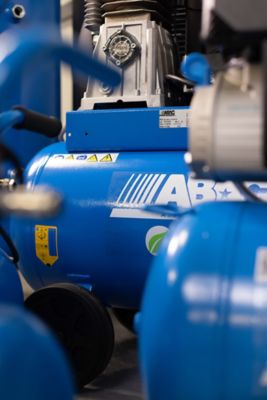Oil-free models need minimal upkeep. Just drain the tank after each use and check for leaks occasionally.
Whether you're inflating tyres, framing a shed, or spraying a coat of paint on your garden furniture, having the right air compressor can make all the difference. This small air compressor buying guide will walk you through the essential factors to consider for your home workshop, highlighting key differences in size, pressure, noise levels, and maintenance.
If you're looking for a reliable and quiet unit that fits in your garage, ABAC Air Compressors offers some of the best options for both beginners and experienced DIYers.
Table of Contents
Choosing the Best Home Garage Air Compressor
A common question: What’s the best home garage air compressor for my needs? The answer depends on your tools and how frequently you’ll be using them. If you’re working on occasional DIY tasks, a compact air compressor for tools like inflators or staplers will do the trick. But if you're using spray guns or sanders, you'll need more power and airflow.
When comparing models, pay close attention to portable air compressor CFM PSI values. In Europe, airflow is usually measured in litres per minute (L/min) and pressure in bar. Most DIY tools require around 6–8 bar, so it’s important to choose a compressor that meets or slightly exceeds this.
If you're looking at American specifications, 1 bar equals about 14.5 PSI (pounds per square inch), and 1 CFM (cubic feet per minute) is roughly 28.3 L/min. Whether you're reading European or US units, understanding these figures will help you choose a compressor that can keep up with your tools.
Know What You’ll Use It For
Before choosing a model, think about the tools you'll be using—and check their air requirements. A portable air compressor CFM PSI chart can be a helpful starting point. Below is a quick guide showing typical needs for common DIY tasks, using both metric and imperial units:
| Task | Air Requirements |
|---|---|
| Inflating tyres, balls | 30–60 L/min (1–2 CFM) @ 6–8 bar (90–115 PSI) |
| Nailers, staplers | 60–85 L/min (2–3 CFM) @ 6–8 bar (90–115 PSI) |
| Airbrushing | 30–85 L/min (1–3 CFM) @ 2–4 bar (30–60 PSI) |
| Spray painting | 115–170 L/min (4–6 CFM) @ 2–4 bar (30–60 PSI) |
| Cleaning tools/surfaces | 115–140 L/min (4–5 CFM) @ 6–8 bar (90–115 PSI) |
These values are a good reference when selecting a compressor. Always choose a model that delivers slightly more airflow and pressure than your tools require to avoid interruptions.
Compressor Tank Size for DIY Tasks
You might think a bigger tank is always better—but that's not always true. The right compressor tank size for DIY depends on the duration and intensity of your tasks.
- For inflating and quick bursts: 6–10 L (1.5–2.5 gal) tanks are light and easy to store.
- For longer or continuous work: 24–50 L (6–13 gal) tanks give you longer airflow without constant motor cycling.
ABAC Air Compressors offer a wide range of tank sizes, so you can pick the one that fits your workshop, budget, and working style.
Noise Level: How Quiet Do You Need?
Noise matters, especially if you're working indoors, in a garage, or at home where neighbours might complain.
- Quiet range: within 70 dB(A)
- Moderate: 70–85 dB(A)
- Loud: 85 dB(A) and up
Oil-Free vs Oil-Lubricated Compressor
Oil-free models are lighter, cleaner, and require little maintenance. Perfect for home garages and light use.
Oil-lubricated models have longer lifespans under heavy loads, but need occasional oil checks.
For most DIYers, oil-free is the way to go—especially for indoor or occasional use. ABAC offers both types, with their oil-free range gaining popularity among hobbyists and weekend warriors.
Air Compressor Maintenance Tips
Even small compressors benefit from regular care. Here are a few key air compressor maintenance tips:
- Drain the tank after each use to prevent moisture build-up.
- Check hoses and fittings for leaks.
- Clean or replace filters as needed.
- If oil-lubricated, check oil levels regularly.
With proper care, even a compact unit can last many years. ABAC’s models are designed for ease of maintenance, with accessible parts and clear service indicators.
Final Thoughts: Choosing the Right Compact Air Compressor for Tools
To sum it up, here’s what to look for when buying a small compressor:
- Match the CFM (l/min) and PSI (bar) to your tools.
- Choose the right tank size for your tasks.
- Decide between oil-free or oil-lubricated models.
- Consider noise level, especially if indoors.
- Prioritise portability and ease of use.
ABAC Air Compressors combine build quality, low-noise technology, and user-friendly features, making them a top choice for anyone looking for the best home garage air compressor. Whether you're powering a spray gun or just keeping tyres inflated, there's a model that fits your project.
Small Air Compressor: Your Questions Answered
It depends on the airflow (CFM or l/min) and tank size. For most small units, it's best to run one tool at a time.
For most home tasks like inflating, nailing, or stapling, a 6–24 L (1.5–6 gal) compressor with 2–5 CFM (60-150 l/min) is usually sufficient.















